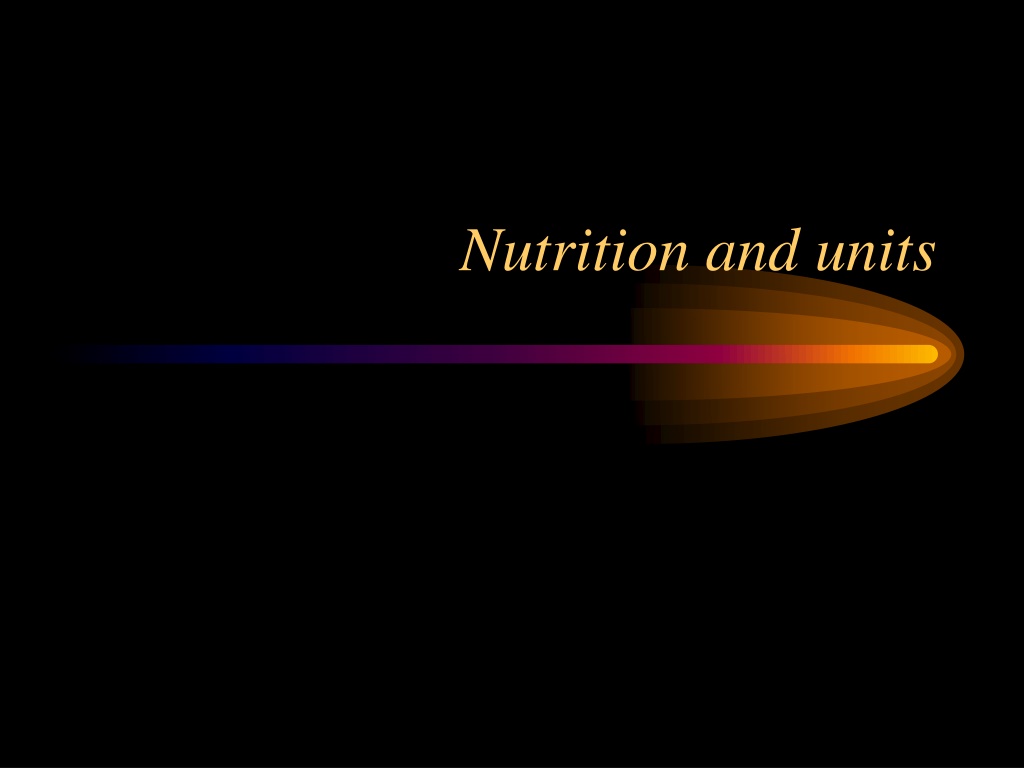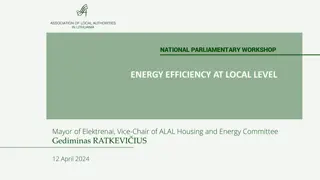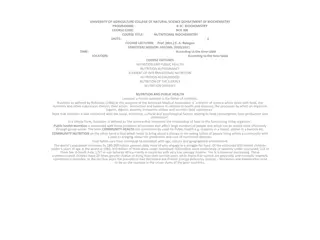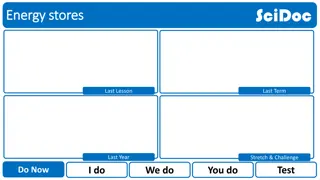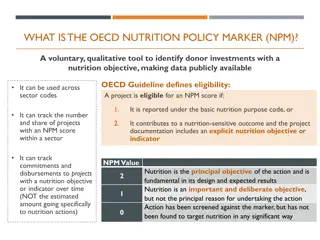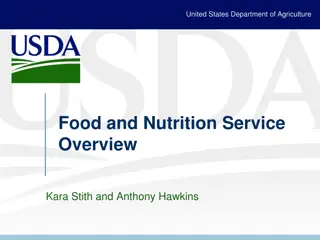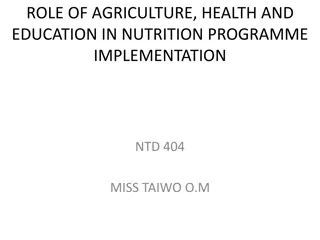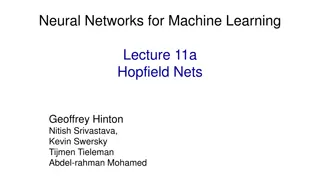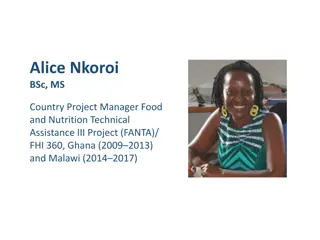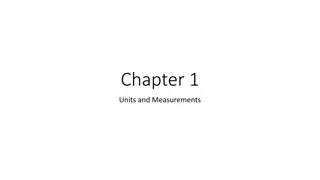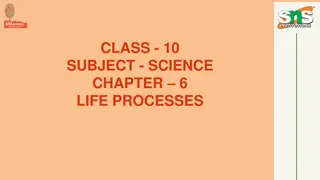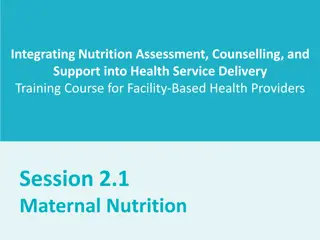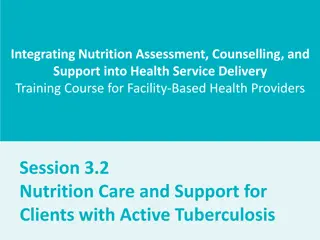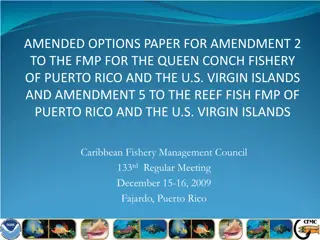Nutrition and Energy Units
Learn about the evolution of energy units in the context of nutrition, from calories to kilocalories, and how they are measured in food labels. Explore the significance of energy content in different macronutrients like carbohydrates, proteins, and fats, and how finding the right balance is essential for a healthy diet. Discover how the energy obtained from food plays a vital role in sustaining various bodily functions and why maintaining an appropriate energy intake is crucial for overall well-being.
Download Presentation

Please find below an Image/Link to download the presentation.
The content on the website is provided AS IS for your information and personal use only. It may not be sold, licensed, or shared on other websites without obtaining consent from the author.If you encounter any issues during the download, it is possible that the publisher has removed the file from their server.
You are allowed to download the files provided on this website for personal or commercial use, subject to the condition that they are used lawfully. All files are the property of their respective owners.
The content on the website is provided AS IS for your information and personal use only. It may not be sold, licensed, or shared on other websites without obtaining consent from the author.
E N D
Presentation Transcript
calories A calorie is the old chemistry metric unit for energy. A calorie is the amount of energy required to raised 1 g of water 1 degree Celsius. In science, there was a broad unification movement to make all sciences use the same units. A joule was the amount of energy commonly used in physics. It is the amount of energy required to accelerate a 1 kg object 1 m/s2for 1 m, or apply 1 N of force for 1 m.
Nutrition and Calories Calorie is an energy measurement just like joules. Calories reported on food labels are actually kilocalories (it does have to be capitalized). 1 Cal = 1000 cal = 4.183 kJ The calories in a food are the amount of energy released during the metabolism reaction of that food.
Elsewhere Other countries are switching their food labels to match the science standard.
Bomb Calorimeter In the past food, was placed in a bomb calorimeter, a sealed container to stop heat transfer, and burned to check the amount of energy released. The heat was used to heat water and it could be calculated. This led to some problems as certain things we eat are indigestible, but they are burnable
Better calculations Now, the amount of proteins, carbohydrates, and fats are separated and measured. We can calculate the caloric content from that and get a much better measure of the energy content of food.
Energy content in foods carbohydrate 4 Cal/g protein 4 Cal/g fat 9 Cal/g There is more you need from food than just energy (vitamins, minerals etc.). There is a certain amount of Calories you need to function. This amount differs for each person, and differs over time. Striking an appropriate balance between these is a healthy diet.
Continued The energy from food is used by your body for everything it does (powering muscles, building new cells, controlling body temperature etc.). If you take in less than you need your body cannot function properly (car without gas). If you take in more than you use, it is stored as fat or glycogen, organic compounds that can be digested later.
Storage The ability of your body to store energy is NOT bad. You would have to eat every hour of your life to survive if you couldn t store energy. Excess long term storage of fat is not healthy for your body. Several methods of removing the excess fat are not healthy either.
Enthalpy ~A measure of heat energy content of a reaction. The symbol for enthalpy is H Enthalpy can only be measured as a change from a standard state. Negative values mean the energy is released (exothermic). Positive value mean the energy is absorbed (endothermic).
How is that different from q q is the change in heat energy. Enthalpy is the change in heat energy per mole for a process or reaction. H = q/n so it is measured in J/mol 2 H2+ O2 2 H2O This means if the reaction is run once with 2 moles of H2and one mole of O2, 572 kJ of energy are released H = -572 kJ/mol
Hesss Law ~In going from a set of reactants to a set of products the change in enthalpy will be the same regardless of how it changed. There is more than one way for a set of reactants to produce a set of products. The overall energy change will be the same no matter how you get there.
Hesss Law example H = 68 kJ N2+ 2 O2 2 NO2 Or N2+ O2 2 NO 2NO + O2 2 NO2 H = 180 kJ H = -112 kJ 68 kJ
Another Hesss Law example Cgraphite+ O2 CO2 H = -394 kJ/mol Cdiamond+ O2 CO2 H = -396 kJ/mol Calculate H for the conversion of graphite to diamond: Cgraphite(s) Cdiamond(s) H for the reverse of a reaction will be the opposite sign.
First Two Laws of thermodynamics 1stlaw of thermodynamics, (Law of conservation of energy) the amount of energy in the universe is constant. E = 0 Energy can be neither created nor destroyed, it can only change forms. 2ndlaw of thermodynamics, in any spontaneous process, or one that happens on its own, there is always an increase in the entropy of the universe. S > 0
The Second Law/Entropy Originally, chemists thought only exothermic reaction could be spontaneous, or happen on their own. That is incorrect. Endothermic reactions can be spontaneous (photosynthesis), and not all exothermic reactions are spontaneous. What makes a reaction spontaneous is an increase in entropy. Entropy (S) is a measure of molecular randomness or disorder of a system.
Questions Predict whether entropy will increase or decrease for each of the following processes. 1. Solid sugar is added to water to form a solution. 2. Iodine vapor condenses on a cold surface to form crystals.
Condensation is a decrease in entropy?!?!? How can anything spontaneously (naturally) condense if it is a decrease in entropy? Water spontaneously condenses on pop cans and plants all the time!?! To answer this, you need to step back and look at the entire universe, not just the system. Sometimes parts of a universe need to be organized (or clumped together) to allow other parts of the maximum amount of disorder.
Cont. Compare how much one thing (system or surroundings) increased in entropy to how much the other thing decreased in entropy. As long as the overall change in entropy for the universe is positive, it can happen spontaneously. Back to water condensing Water doesn t condense on pop cans. Water condenses on COLD pop cans, in warm moist air. Water doesn t condense on warm pop cans in the same surrounding, or cold pop cans in a cold surrounding (fridge)
Cont. again A cold pop can in a warmer area is a state of low entropy. In order to increase the entropy of the pop can s temperature, heat needs to transfer from the surrounding area to the pop can. S = + In doing so, this forces the water vapor to condense decreasing entropy. S = - Which change is greater? Without calculations, we can conclude that the entropy increases more than it decreases for an overall positive S for the universe because this process happens spontaneously.
Universe= system + surroundings It helps to break the entropy up into the categories of universe, system and surroundings Suniverse= Ssystem+ Ssurroundings Suniv> 0, then the entropy of the universe increases and the process is spontaneous or happens on its own. If Suniv< 0, the process is not spontaneous. If Suniv= 0, then the system is at equilibrium.
Question Plants and animals grow. This is an obvious decrease in entropy. Are all living things a violation of the 2ndlaw of thermodynamics? In any living organism, large molecules are assembled from smaller ones. Is this process consistent with the second law? Yes, as long as other processes that force this to happen in the cell obtain a larger increase in entropy than the decrease in entropy by the creation of the larger molecule.
Answer Living things don t grow isolated from the universe. In order to grow, an animal must eat. What is eating? Taking large complex molecules and breaking them down to smaller molecules to release energy. This is a large increase in entropy. Again, based off observation we can say these other processes do have a larger increase in entropy because this action does happen spontaneously.
Plants Plant s don t eat. They actually do undergo cellular respiration, so in a sense they do eat , they just make their own food. In order to make their food, plants need to be next to a source to a of increasing entropy. That is the Sun. This is how all nonspontaneous reactions are forced to occur. They are placed in an environment where something else will increase in entropy.
